Do you ever feel lost trying to figure out where your website traffic is coming from? For new digital marketers, this can be one of the trickiest parts of growing an online presence. Without the right tools, it’s nearly impossible to know which efforts are driving results.
That’s where UTM parameters come in. These simple yet powerful tools help you track exactly where your visitors are coming from, so you can stop guessing and start making smarter marketing decisions.
At OptinMonster, we’ve helped over 1.2 million websites optimize their traffic and boost conversions using tools like UTM parameters. Whether you’re running ads, email campaigns, or social media promotions, understanding your traffic sources is the first step to success.
- What Is Traffic Attribution?
- What Are UTM Parameters?
- How to Create Trackable UTM Parameters
- 3 UTM Parameter Best Practices
- Get the Most from UTMs with MonsterInsights
- Use UTMs to Convert More Website Visitors
What Is Traffic Attribution?
Traffic attribution is understanding the source of where your site’s traffic comes from. Knowing which sources drive traffic to your website is invaluable for optimizing your marketing strategy.
Traffic attribution is the key to getting more conversions for many reasons. But here are the 2 most important ones. Traffic attribution:
- Helps you connect more deeply with your audience
- Gives you valuable metrics to calculate things like cost-per-click (CPC), return on ad investment (ROAS), cost-per-acquisition (CPA), and much more
First, understanding where your audience came from lets you connect with them on a more personal level.
In the past, we’ve written about the best ways to personalize your optins to get higher conversions. As you can imagine, linking custom campaigns to the source of your traffic can play a huge role in this personalization.
Imagine the ability to tailor the language of your optin campaigns to the traffic source that brought them in the first place.
If someone reaches your site via Instagram, for example, you could show them a campaign like this one:
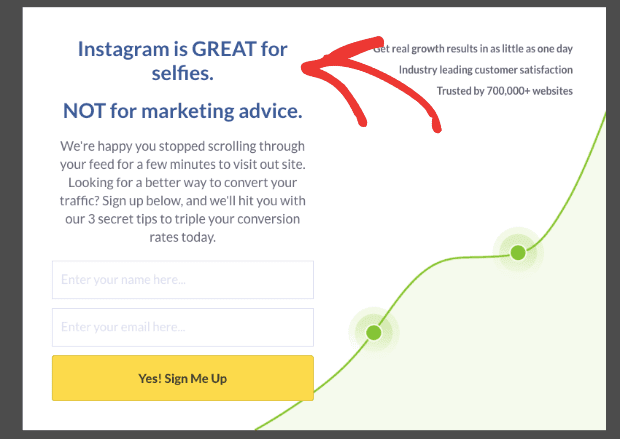
Then you could set up a similar campaign for visitors coming from Facebook:
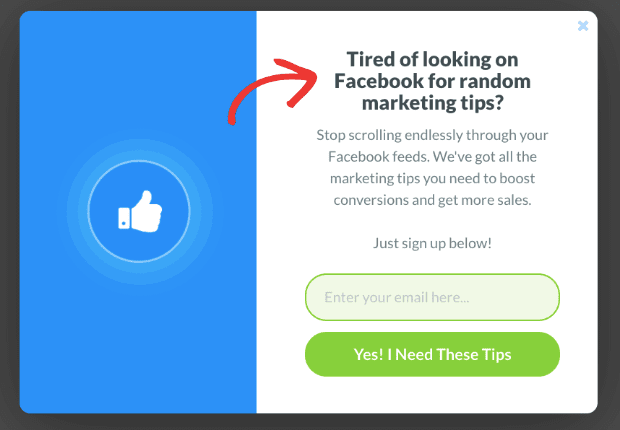
By personalizing subtle aspects of your optin campaigns, you can improve user experience (UX) and simultaneously boost conversions.
At the end of this article, we’ll dive further into campaign personalization for referral sources.
But beyond deepening the relationship with your site’s visitors, traffic attribution is valuable for tracking the source of conversions.
Imagine a scenario where you’re driving both paid and organic traffic. And from those 2 strategies, you convert 50 new customers each month.
At face value, that information doesn’t do anything for you.
You could be getting 45 customers from paid ads and 5 from organic searches. Or the reverse could be true: if your SEO game is good, you could be getting loads of organic traffic and waste money on paid ads every month.
The point is that traffic attribution helps you make a more accurate budget of your time, money, and resources. Without it, you’ll never have a clear idea of how to get the most conversions from your site.
Let’s turn our attention to UTM parameters, which help you understand what sources are driving the most traffic to your business.
What Are UTM Parameters?
UTM parameters (short for Urchin Tracking Modules) are small bits of text added to the end of a URL. They help you track exactly where your website traffic is coming from. By using UTMs, you can see how well your marketing efforts are working.
How does it work? Let’s say you have a page for a new product launch, and you’re going to link to that page on social media, in email marketing campaigns, in guest blogs, and in PPC ads. When you use unique UTM parameters for the links you use on each of these marketing channels, you’ll be able to track your traffic sources in Google Analytics.
There are 5 UTM parameters you can use to make your links trackable:
- Source (required): Where the traffic is coming from, like “Facebook” or “Google.”
- Medium (required): The type of marketing channel, like “email” or “CPC” (cost-per-click).
- Campaign (required): A label for your specific campaign, like “spring_promo” or “black_friday.”
- Term (optional): Keywords you’re targeting in paid ads (useful for Google Ads).
- Content (optional): A way to distinguish between variations of the same campaign, like different versions of an email.
How to Create Trackable UTM Parameters With Google’s Campaign URL Builder
At first, UTMs might seem a bit technical, but they’re easier to use than you think, especially with Google’s free Campaign URL Builder tool. It lets you add UTM parameters to any URL in less than a minute, simply by filling out this form:

Here’s an example of how it could work.
Your company is running an email campaign to promote a spring sale. You want to track how many people visit your site from the email. Here’s how you’d set up a URL with UTM parameters:
- Go to Google’s Campaign URL Builder: This free tool lets you build trackable links in minutes.
Here’s the link to Google’s Campaign URL Builder. - Enter the destination URL: Add the link to the page you want to drive traffic to. For example:
https://yourwebsite.com/spring-sale - Fill out the UTM fields:
- Campaign Source: Enter “newsletter” to track visits from your email.
- Campaign Medium: Enter “email” to specify the type of traffic.
- Campaign Name: Enter “spring_promo” to identify this specific campaign.
- Optional fields: If you’re testing different versions of the email, you could use the Content parameter (like “version_a” or “version_b”) to compare results.
Here’s what the finished URL might look like:https://yourwebsite.com/spring-sale?utm_source=newsletter&utm_medium=email&utm_campaign=spring_promo
- Use the URL in your email: Copy the link and insert it into your email’s call-to-action, like “Shop the Sale Now!”
Now, when visitors click that link, you’ll know exactly which email brought them to your site. This helps you measure the performance of your campaign and make data-driven decisions.
UTM parameters are essential for tracking your marketing campaigns. They tell you which sources are driving traffic and conversions, so you can focus your time and budget on what works best. Without them, you’re left guessing and might waste resources on campaigns that aren’t effective.
3 UTM Parameter Best Practices
Ready to start tracking your traffic sources with UTM parameters? Here 3 tips to help you succeed.
1. Be Specific With Your Campaign Labels
As you’re coming up with labels for your UTMs, be as specific as possible with each parameter.
Let’s say, for example, you want to track how many visitors come to your blog post from an Instagram post. That way, you can personalize your landing page to your audience who use Instagram.
Some marketers make the mistake of labeling their Source as ‘social media.’
This parameter label is too vague. After all, social media could be Facebook, X (formerly Twitter), LinkedIn, or any other social media platform you use for your business.
Remember, the goal of UTMs is to provide you with exact data on where your traffic is coming from. It can only do that if you set up your UTMs with highly specific labels.
In the example above, you would want to mark the Source as ‘instagram.’ That way, you know exactly which platform brought traffic from that campaign.
2. Stay Consistent in Your Label Names
You need to develop consistency with your label names. This is particularly important if you’re part of a marketing team.
If you’re tracking a campaign with the Source as “Facebook,” and your colleague does the same with the Source labeled as “facebook,” the two will be tracked differently.
Set up some teamwide rules for creating UTMs, including things like:
- Capitalization
- Use of spaces
- Adding hyphens
- Whether or not to add numbers, like the year
And so on.
The easiest way to approach this is to strip away grammar rules altogether for UTM parameters. That means no capitalization and using hyphens instead of spaces.
Whichever system you choose to build, be sure your team is in agreement. Otherwise, you’ll end up with multiple UTM URLs for the same campaign, which will complicate your tracking.
3. Set up Goals to Track Revenue
This is the last area that marketers tend to get lazy with.
Using UTMs for traffic attribution is great. You know what’s even better? Using that data to calculate how that traffic is turning into revenue.
For that, you have 3 options:
- Hook up your UTM links to your customer relationship management software (CRM)
- Create goals in Google Analytics
- Let MonsterInsights create and track goals automatically
Most modern CRMs will help you track your UTM links and calculate a conversion attribution rate. These types of automated marketing tools can be huge time savers.
But they can also be expensive.
You can use Google Analytics to set up custom reports absolutely free. The only problem is that most marketers are intimidated by this.
Creating goals in Google Analytics can be tedious, time-consuming, and confusing if you’re not a data-driven marketer.
Thankfully, there’s option #3: using MonsterInsights to automate and streamline the entire process.
Let’s look at how easy MonsterInsights makes UTM campaign tracking for you.
Get the Most From UTMs With MonsterInsights
Sometimes it can be tough to stay organized. Considering all the campaigns you have with your marketing team, coordination can feel overwhelming.
That’s why we highly recommend working with MonsterInsights.
MonsterInsights is the world’s #1 WordPress plugin for Google Analytics. It has all the metrics you need to build a more strategic marketing plan.
There’s even an overview report so you can quickly get the essential information you need every day:
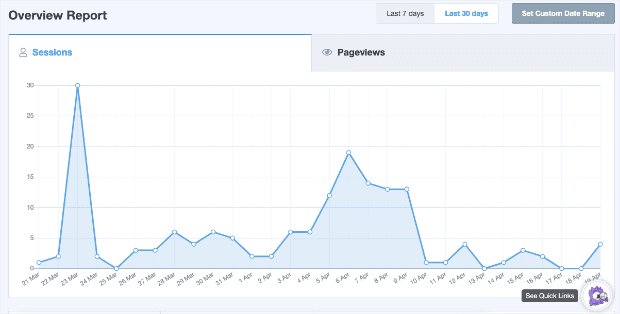
But it’s MonsterInsight’s campaign builder that simplifies your life when it comes to UTMs. They use a URL builder exactly like Google’s Campaign URL Builder.
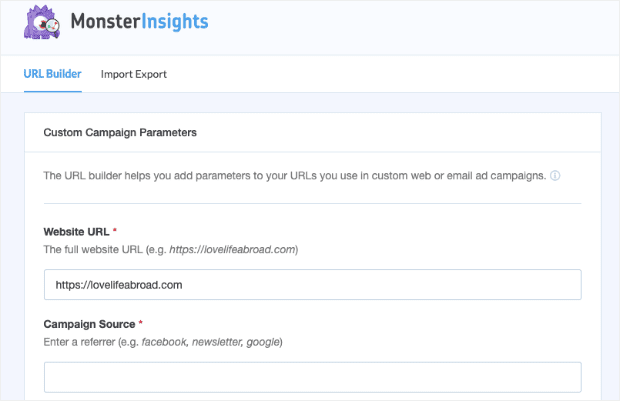
The only difference is that everything is kept in the same place, and all the data automatically goes conveniently into your Google Analytics account.
So you can build a custom UTM with Source, Medium, Name, Term, and Content parameters directly in MonsterInsights.
Then you can head over to your Google Analytics account and go to Acquisition » Campaigns » All Campaigns.
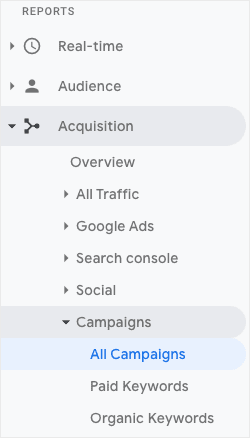
This will show you all the campaigns you’ve built with MonsterInsights in an organized way:
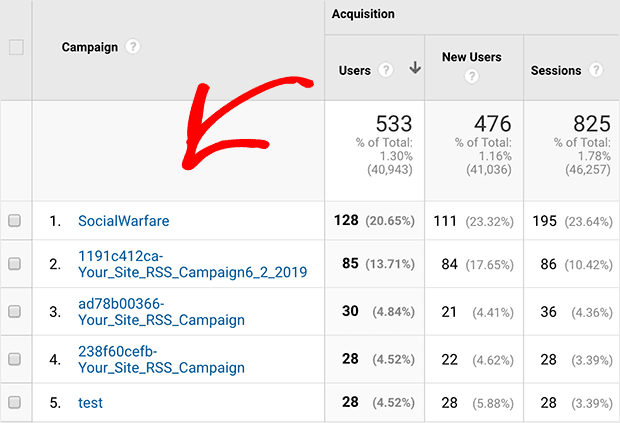
Here’s the best part though: MonsterInsights also creates and tracks goals for your campaigns.
With the MonsterInsights eCommerce Tracking addon, you get details on how your traffic is interacting with your site.
That includes key metrics such as:
- Conversion rate
- Transaction
- Revenue
- Top-performing products
- Average order value
And more.
What’s most important for our purposes today, though, is that you can see the referral information for each of your referral sources.
In other words, you’ll see exactly how much money is coming from each of your UTMs built with MonsterInsights.

More than other analytics tools, MonsterInsights gives you the metrics you need to make smarter marketing decisions. Relying on data from UTMs, content marketing can become a refined, highly profitable system in your business.
Get started with MonsterInsights.
Use UTMs to Convert More Website Visitors
A lot of new marketers make the mistake of forgetting why they’re setting up UTMs in the first place:
To build a better marketing strategy that converts traffic.
In other words, knowing exactly where your traffic is coming from is just the means to an end. Your overall goal is to use that data to increase your conversion rate.
That’s where OptinMonster comes in:

OptinMonster lets you add popups, floating bars, and other marketing campaigns to your site and target them to the right audience.
Among our robust targeting rules are Referrer Detection and Query Argument targeting, which let you use your UTM data to target your campaigns.
1. Referrer Detection
Referrer Detection allows OptinMonster to track where a visitor came from before landing on your site. It identifies the referral source, such as Facebook, Google, or another website.
How It Works: When someone clicks a link to your site, their browser sends referrer data to your website. OptinMonster uses this data to trigger campaigns for visitors based on where they came from.
Relation to UTMs and Traffic Attribution:
- Referrer detection complements UTM parameters by providing a broader view of visitor origins, even when UTMs aren’t used.
- For example, if a visitor clicks a link from Facebook, you can show them a campaign tailored to Facebook users, like “Thanks for visiting from Facebook! Check out this exclusive offer.”
2. Query Argument Targeting
Query Argument Targeting tracks specific parameters in a URL, such as UTM codes or other query strings, to trigger custom campaigns.
How It Works: OptinMonster looks for query arguments like ?utm_source=newsletter&utm_campaign=spring_promo in your URL. You can create rules to display campaigns based on these parameters.
Relation to UTMs and Traffic Attribution:
- Query argument targeting is directly tied to UTM parameters.
- For example, if your UTM campaign name is
spring_promo, you can show a campaign like “Welcome to our Spring Sale!” to visitors who arrive via that UTM-tagged link. - This lets you create hyper-targeted messages for specific traffic sources, campaigns, or content variations.
Why These Features Matter
Both Referrer Detection and Query Argument Targeting help you personalize your website experience based on where your visitors come from and why they’re there. By combining these tools with UTM parameters, you can fine-tune your traffic attribution and improve your conversion rates with targeted messaging.
For example:
- Use Referrer Detection to tailor campaigns broadly by platform or source (like all visitors from Facebook).
- Use Query Argument Targeting to get specific, customizing campaigns for visitors from a single email or ad campaign using detailed UTM parameters.
With OptinMonster, you can maximize the impact of your marketing campaigns and connect more effectively with your audience.
Improve Your Marketing With UTM Parameters
When you track your traffic attribution with UTM parameters, you get a better picture of which marketing strategies are driving your traffic. And when you combine UTM URLS with tools like MonsterInsights and OptinMonster, you can start seeing results quickly.
Learn more about improving website traffic and conversions:

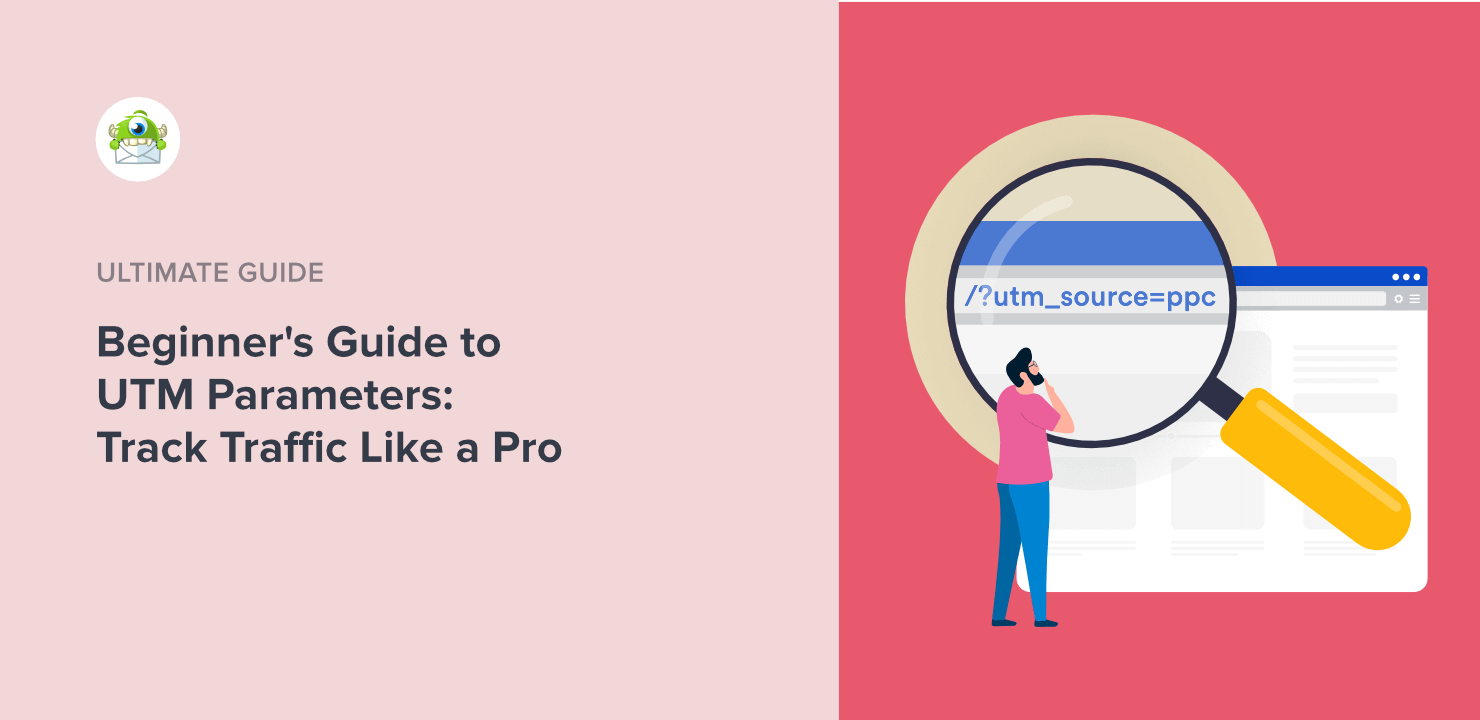
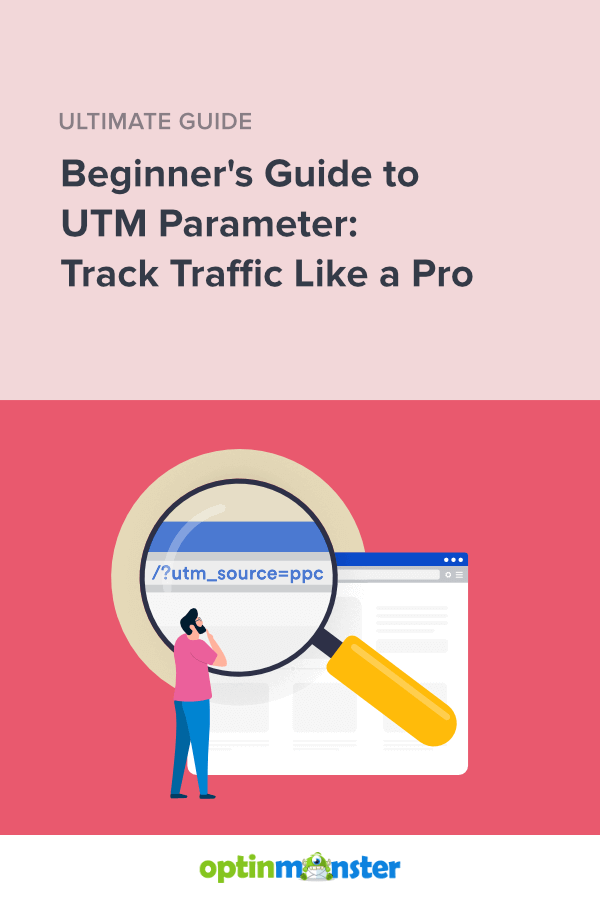




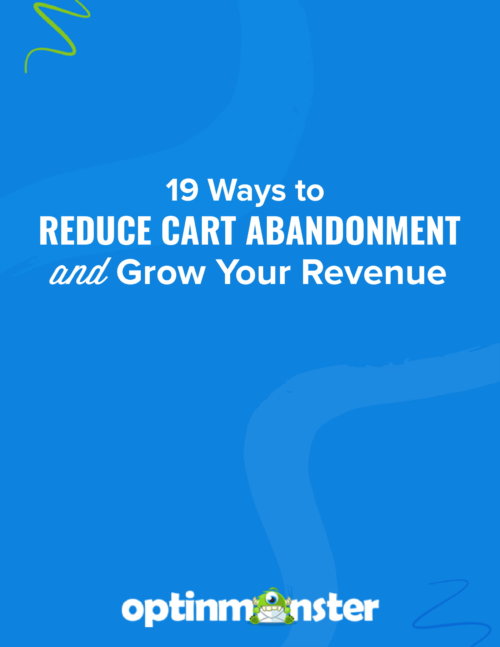



Add a Comment